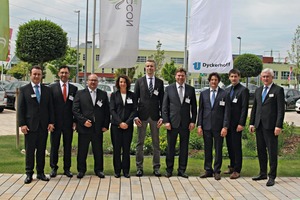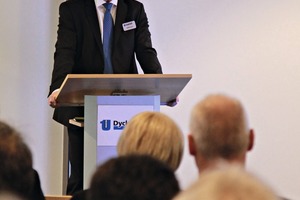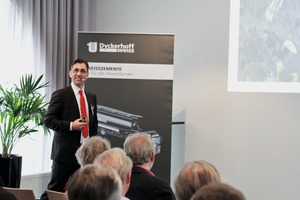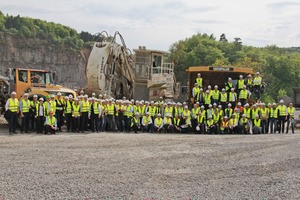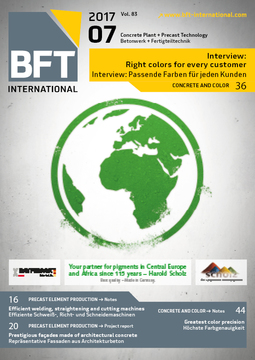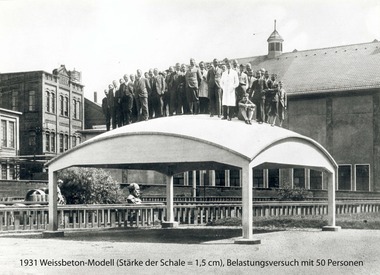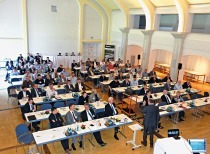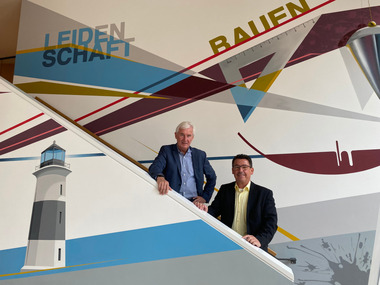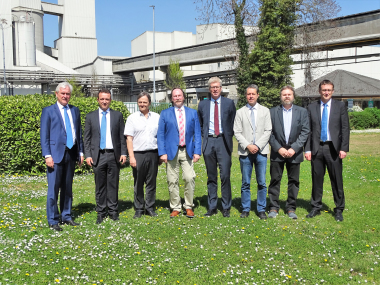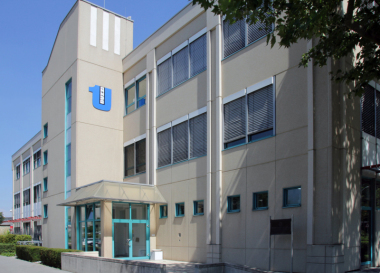Prospects for concrete products [Video]
This year’s traditional Dyckerhoff Weiss concrete ashlar meeting was not held in Wiesbaden, as usual, but approximately 70 km away in Bensheim on the Bergstraße. The event had taken “The future is not a given; the future is created” as its theme and addressed the future pro-spects of the concrete ashlar industry. Terms such as “innovation” and “future” were the key-words that came up again and again in the total of six “kick-off presentations” announced by Martin Möllmann, director at Dyckerhoff GmbH and in charge of product marketing and white cement sales, during his welcome speech to the more than 130 guests at the Tobbaccon Hotel in Bensheim.
Right at the beginning of the meeting, Dr.-Ing. Dennys Dressel, head of Dyckerhoff’s applica-tions technology division, addressed “Concrete ashlar and exposed concrete with state-of-the-art admixtures”. He used application examples to demonstrate how workability, the hardening process and post-processing can be controlled by means of state-of-the-art admixtures. The re-sults are, among other things, improved surface quality and an accelerated progress of opera-tions.
Modern concretes and light
State-of-the-art concrete technology was also the subject of the presentation given by Dr.-Ing. Stephan Hauser, owner of Ducon Europe GmbH & Co. KG in Mörfelden. He not only intro-duced the Ducon “micro-reinforced high-performance concrete” and its entire range of tech-nical properties but also presented numerous potential fields of application such as explosion or earthquake protection.
Dipl.-Ing. Andrea Kreuzburg from the Wilhelm Dyckerhoff Institute (WDI) in Wiesbaden continued looking to the future with her presentation on “photocatalytically active concrete surfaces” and the “findings from research and development” derived therefrom. Dr.-Ing. Andreas Roye, managing director of Stolberg-based Lucem GmbH, explored the question of “how to get the light into the concrete” and presented the “technology and case examples of translucent concrete”.
A vision of the future
Sven Marasek from OGS Gesell-schaft für Datenverarbeitung und Systemberatung mbH based in Koblenz addressed the subject of “Industry 4.0 and the use of apps in the concrete plant”. To show how the increasing digitization of analog procedures and the integration of new technologies could look like, Marasek used a specific app which not only displays the current delivery status but also initializes the retrieval of materials just in time.
In the final lecture, Dr.-Ing. Dirk Lowke from the Technical University of Munich presented “architectural concrete from the 3D printer”. After outlining different printing techniques, such as the “Extrusion-Deposition Technique” and “Particle-bed 3D-Printing Technique”, he showed videos that provided impressive evidence of how an “additive production of multi-functional, poured-in-place wall elements by means of lightweight concrete extrusion” can be realized and how “structurally optimized, multifunctional exterior wall elements without addi-tional thermal insulation” can be produced using state-of-the-art printing technologies.
Rock blasting “live”
in a granite quarry
The day was rounded off perfectly in the nearby town of Heppenheim. Dipl.-Ing. (FH) Marco Röhrig, who had previously presented Röhrig Granit mbH during the Bensheim meeting, took the participants on an informative and highly interesting tour of the company’s granite quarry.
The extracted materials are mainly used as aggregates in landscaping, ready-mixed concrete, road construction and face concrete (exposed concrete).
The “live” blasting operation, organized right down to the smallest detail and carried out to perfection, was undoubtedly the spectacular highlight of the tour of the Heppenheim quarry. A truly “thunderous” and at the same time highly impressive ending to this year’s Dyckerhoff Weiss concrete ashlar meeting.

